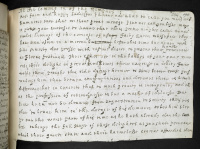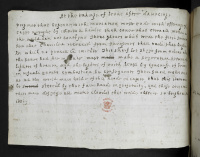Royal Entertainment: Hermit and Nymphs: Difference between revisions
mNo edit summary |
|||
| Line 13: | Line 13: | ||
{| style="float: right; border: 1px solid #BBB; margin: .46em 0 0 .2em;" | |||
|- style="font-size: 86%;" | |||
| valign="top" |[[File:cotton_ms_titus_c_vi_f204r.jpg|200px|thumb|left|fol. 204r]] | |||
|} | |||
:'''[fol. 204r]''' | :'''[fol. 204r]''' | ||
:At the coming in of the Nimphes: | :At the coming in of the Nimphes: | ||
| Line 19: | Line 22: | ||
:[''The leaf is cut here and some words that follow below are now illegible''.] | :[''The leaf is cut here and some words that follow below are now illegible''.] | ||
<br /> | <br /> | ||
{| style="float: right; border: 1px solid #BBB; margin: .46em 0 0 .2em;" | |||
|- style="font-size: 86%;" | |||
| valign="top" |[[File:cotton_ms_titus_c_vi_f204v.jpg|200px|thumb|left|fol. 204v]] | |||
|} | |||
:'''[fol. 204v]''' | :'''[fol. 204v]''' | ||
:At the takinge of leaue after dauncinge | :At the takinge of leaue after dauncinge | ||
:Virgines that beginne with inuocation must ende with offeringe This cappe wrought by im''m''ortall handes shall couer that eternall motion in the world can not conteyne Theas gloues which wear the first swete token that Chariclea receauid from Theagenes shall vaile that brightnesse which no pencill ca''n'' imitate This skarf let slippe from Helene when the Satire had hir in chace must <strike>make</strike> make a seperation betwen the lightes of heauen and the lightes of earth least by concurse of beames in visuali puncto cumbustion be consequente Their finall wishes are that all the world, maie holde of this heade in capite, that this state maie be <strike>steerid</strike> steerid by that faire hande in perpetuity, and those orientall raies maie disperse all mistie clowdes that wolde obserue so bright a Maiesty. | :Virgines that beginne with inuocation must ende with offeringe This cappe wrought by im''m''ortall handes shall couer that eternall motion in the world can not conteyne Theas gloues which wear the first swete token that Chariclea receauid from Theagenes shall vaile that brightnesse which no pencill ca''n'' imitate This skarf let slippe from Helene when the Satire had hir in chace must <strike>make</strike> make a seperation betwen the lightes of heauen and the lightes of earth least by concurse of beames in visuali puncto cumbustion be consequente Their finall wishes are that all the world, maie holde of this heade in capite, that this state maie be <strike>steerid</strike> steerid by that faire hande in perpetuity, and those orientall raies maie disperse all mistie clowdes that wolde obserue so bright a Maiesty. | ||
==Theatrical Provenance== | ==Theatrical Provenance== | ||
Revision as of 11:22, 8 July 2018
Henry Howard? (1595?)
N.B. The title used here is taken from Wiggins
Historical Records
Manuscript Fragment
Three fragments of dramatic royal entertainment survive in adjacent leaves among the papers of Lord Henry Howard, later Earl of Northampton, and written in his hand (British Library, MS Cotton Titus C vi, fols. 203r–204v). While all three fragments appear to have been composed to be performed in the presence of Queen Elizabeth, it is unclear whether they constitute elements taken from the same entertainment or from two distinct entertainments. D.C. Andersson, who first announced the discovery of the fragments in 2008, proposed that they were from the same event. This entry follows Wiggins, who assumes that they represents two events: one, a tilt entertainment, and the other, a royal progress entertainment. (For the other entry, see "Tilt Entertainment (?): Merlin and Pilgrims".)
The following transcription reproduces the two speeches that appear on fol. 204r-v.
- [fol. 204r]
- At the coming in of the Nimphes:
- Most faire and happy ladie (for I knowe not what to calle you more) and I am verie sure that without great wronge I can not call you lesse maye it please your curtesie to knowe that theas pretie nimphes callid Hamadriades hearinge of the cominge of a
fairyFairy Queen whose face they haue seen often in a mirrorbut neuerbefor this time but neuer with like Maiesty doo presse with infinit desire to present their humble reuerencie at Floras festiuall Their celles are in the bankes of your owne riueres, their delight in green meddowes their exercise in iollity Faine wolde theie prouoke this olde dotinge hermite to some better course perswadinge him that betwen contemplations and dreames thear is littell difference but in conceite that to much grauity is incongruity and that the profession of retirednesse is but a maske of idelnesse. But since he can not be drawne from sequestration to society they resolue to leaue him in the dotage of his demurre to set him sleepe out the worst parte of his time as he hath already don thebestbest takenge the full scope of those delightes as you shall perceaue which their quiete state and their harmelesse content affordith them - [The leaf is cut here and some words that follow below are now illegible.]
- [fol. 204v]
- At the takinge of leaue after dauncinge
- Virgines that beginne with inuocation must ende with offeringe This cappe wrought by immortall handes shall couer that eternall motion in the world can not conteyne Theas gloues which wear the first swete token that Chariclea receauid from Theagenes shall vaile that brightnesse which no pencill can imitate This skarf let slippe from Helene when the Satire had hir in chace must
makemake a seperation betwen the lightes of heauen and the lightes of earth least by concurse of beames in visuali puncto cumbustion be consequente Their finall wishes are that all the world, maie holde of this heade in capite, that this state maie besteeridsteerid by that faire hande in perpetuity, and those orientall raies maie disperse all mistie clowdes that wolde obserue so bright a Maiesty.
Theatrical Provenance
Presumably intended for performance before Queen Elizabeth. Wiggins's assignment of the entertainment is 1595 is extremely tentative.
Probable Genre(s)
Masque (Andersson); entertainment (Wiggins).
Possible Narrative and Dramatic Sources or Analogues
Thomas Elyot described Hamadryads as "Nymphes or fayries of the wooddes." In classical mythology, each nymph's life was associated with a specific tree.
The speech's allusion to Chariclea and Theagenes refers to Heliodorus' Aethiopica.
References to the Play
None known. (Information welcome.)
Critical Commentary
Andersson, who discovered the speeches, first proposed Lord Henry Howard as the author and a composition date in the 1590s on the basis of paleographic evidence (172-73). Andersson assumed that all three speeches were written for the same event.
Wiggins (#998) proposed that the two present speeches may have been written for a royal progress entertainment. The allusion to "Floras festiuall," suggesting the Roman Floralia (April 28–May 3), might indicate the time in which the entertainment occurred; however, no known royal visit matches perfectly with all the evidence.
For What It's Worth
Although the leaf containing these two speeches appears in Herbert's papers adjacent to the leaf containing the speech for the "Merlin" entertainment, the nature of Herbert's inscription is very different. The "Merlin" speech is heavily marked up with currente calamo revisions, evidently as the author composed his first draft; by contrast, the present speeches evince basically no revision at all, perhaps indicating that Herbert was simply copying speeches for an event that had already taken place, rather than composing speeches for an event that was to come.
Works Cited
Site created and maintained by Misha Teramura, University of Toronto; updated 18 June 2018.

